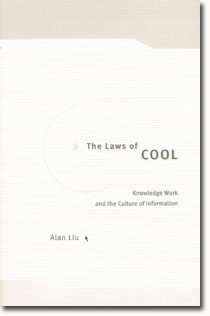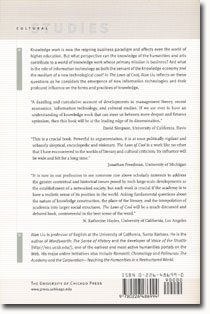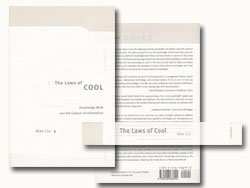University of Chicago Press, 2004, 552 pages, ISBN-10: 0226486990, ISBN-13: 978-0226486994 (fuller precis of book)
“Knowledge work” is now the reigning business paradigm and affects even the world of higher education. But what perspective can the knowledge of the humanities and arts contribute to a world of knowledge work whose primary mission is business? And what is the role of information technology as both the servant of the knowledge economy and the medium of a new technological cool?
In The Laws of Cool, Alan Liu reflects on these questions as he considers the emergence of new information technologies and their profound influence on the forms and practices of knowledge. Liu first explores the nature of postindustrial corporate culture, studies the rise of digital technologies, and charts their dramatic effect on business. He then shows how such technologies have given rise to a new high-tech culture of cool. At the core of this book are an assessment of this new cool and a measured consideration of its potential and limitations as a popular new humanism.
According to Liu, cool at once mimics and resists the postindustrial credo of innovation and creative destruction, which holds that the old must perpetually give way to the new. Information, he maintains, is no longer used by the cool just to revolutionize human knowledge—it is also used to resist it. What counts as cool today, however, is too frequently narrow, shallow, and self-centered. The challenge for the humanities, then, is to help redefine cool and to use technology in a way that mediates between knowledge work and a fuller lifework glimpsed in historical lives and works.
A study of enormous scope, ambition, and intellect, The Laws
of Cool provides an indispensable account of knowledge work
today and its future.
[Original draft of catalog copy]
In The Laws of Cool, Alan Liu thinks about knowledge work in contemporary society from the viewpoint of the historical, critical, and aesthetic knowledges valued by the humanities and arts. He also looks through the glass in the other direction to reflect on the evolving nature of the humanities and arts under the pressure of the newly dominant, corporate knowledge cultures of lifelong learning,learning organizations, team work, and diversity management. Liu’s pivotal topic is information technology and its semi-autonomous culture of cool (as in Web pages so cool that they thwart the flow of information). Information cool, as he calls it, is now the symptom not just of consumer culture but of a producer culture–the culture of the cubicle–that seeks an “ethos of the unknown” within the world of knowledge work.
Liu draws on contemporary business theory, sociology, anthropology, art, literature, literary theory, cultural studies, history of information technology, and Internet and new media theory to create an argument that is at once historical, formal, and theoretical. After articulating the concept of postindustrial knowledge work, he narrates the rise of information technology in the workplace and the cognate rise of cool subcultures, countercultures, and cubicle “intracultures.” He then focuses on the formal, technical, social, and political features of high-tech “information cool” and concludes with a sustained reflection–and some practical suggestions–on how the humanities and arts can help educate the contemporary generations of cool.
One of Liu’s special concerns is the emergence of new “destructively creative” or viral arts that resist the postindustrial credo of innovation or what economist Joseph Schumpeter called creative destruction. Another is the current humanities emphasis on historicist critique, which also reevaluates the process of creative destruction. How might these twin tendencies in recent humanities and arts collaborate, he asks, to help shape the well-being–or wealth in a deeper sense–of the new classes of knowledge who spend their days and nights staring at a computer screen and wishing they were cool?
Since the early 1990s, Liu has built on his work in literary history, theory, and cultural criticism by exploring contemporary information culture through a number of technology projects, including his Voice of the Shuttle Web site and Transcriptions: Literary History and the Culture of Information (the NEH-funded research and curricular development initiative he directs). The Laws of Cool harvests the practical and theoretical experience gained in such projects.
 |
Table of Contents
Introduction: Literature and Creative Destruction Part I. The New Enlightenment Preface “Unnice Work”: Knowledge Work and the Academy
Part II. Ice Ages Preface “We Work Here, But We’re Cool”
Part III. The Laws of Cool Preface “What’s Cool?” (excerpt)
Part IV. Humanities and Arts in the Age of Knowledge Preface “More”
Epilogue Appendices
|




